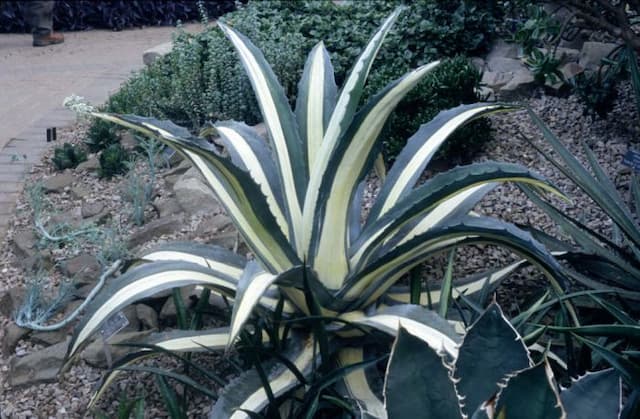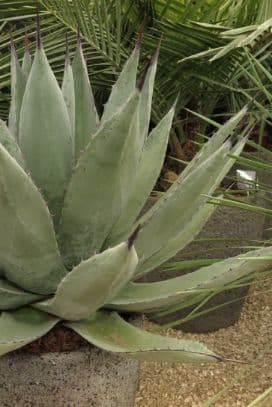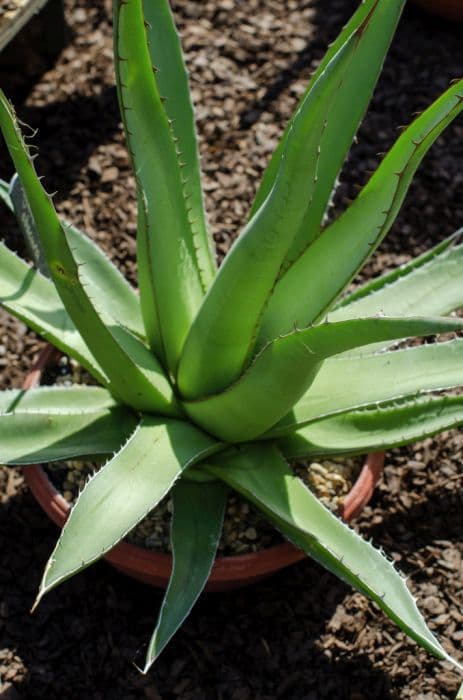Adam's needle Yucca filamentosa 'Bright Edge' (v)

ABOUT
The Yucca filamentosa 'Bright Edge', commonly known as Bright Edge Yucca or Adam's Needle, features distinct sword-shaped leaves that form a spiky, spherical clump. Its foliage is variegated, with each leaf exhibiting a vibrant green center flanked by creamy to bright yellow edges, providing a striking contrast. The leaves are edged with curly, thread-like filaments that add an additional element of texture. During the warmer months, the Bright Edge Yucca may produce tall flower spikes adorned with bell-shaped, creamy white flowers that rise above the foliage, attracting various pollinators. The overall impression is that of a hardy and architectural plant, adding year-round interest with its evergreen foliage and seasonal blooms.
About this plant
 Names
NamesFamily
Asparagaceae
Synonyms
Adam's Needle, Needle Palm, Thread-Leaf Yucca, Silk Grass
Common names
Yucca filamentosa 'Bright Edge'
 Toxicity
ToxicityTo humans
Adam's needle (Yucca filamentosa 'Bright Edge') is not considered highly toxic to humans, but it can still cause some discomfort if ingested. The saponins present in the plant can lead to digestive irritation if one consumes a significant amount of its leaves or other plant parts. Symptoms that might arise include nausea, vomiting, and diarrhea. Much like with other non-edible ornamentals, it is generally a good idea to avoid ingesting parts of this plant.
To pets
Adam's needle can also be toxic to pets. Similar to its effects on humans, the saponins within the plant can cause gastrointestinal upset in animals if they ingest it. Symptoms of poisoning in pets may include vomiting, diarrhea, and in some cases, rare drooling. It is advisable for pet owners to prevent their animals from chewing on or consuming this plant to avoid any potential health issues.
 Characteristics
CharacteristicsLife cycle
Perennials
Foliage type
Evergreen
Color of leaves
Variegated
Flower color
White
Height
2-3 feet (0.6-0.9 meters)
Spread
2-3 feet (0.6-0.9 meters)
Plant type
Shrub
Hardiness zones
4-10
Native area
Southeastern United States
Benefits
 General Benefits
General Benefits- Drought tolerant: Yucca filamentosa 'Bright Edge' requires minimal water once established, making it ideal for water-wise gardens.
- Low maintenance: This plant has minimal pruning and feeding requirements, reducing garden upkeep efforts.
- Attracts wildlife: It provides nectar for pollinators such as butterflies and can also be a habitat for beneficial insects.
- Architectural interest: With its sword-shaped leaves and striking coloration, it adds a visual focal point to landscapes.
- Versatile in landscape use: It's suitable for rock gardens, borders, and xeriscaping, offering flexibility in garden design.
- Evergreen: Yucca filamentosa 'Bright Edge' retains its foliage year-round, providing constant color and texture to gardens.
- Long blooming period: Its long white, bell-shaped flowers bloom in summer, offering visual interest for an extended period.
 Medical Properties
Medical Properties- This plant is not used for medical purposes.
 Air-purifying Qualities
Air-purifying QualitiesThis plant is not specifically known for air purifying qualities.
 Other Uses
Other Uses- Fiber Source: The long, strong fibers of the Yucca plant can be used for making ropes, twines, and other cordage items.
- Soap Substitute: The roots of Yucca contain saponins that can be used to make a natural soap or shampoo.
- Photography: Yucca 'Bright Edge' has striking foliage and flowers that can be used as a picturesque subject for photographers, especially those interested in plant and garden photography.
- Fish Poison: Historically, some Native American tribes used the saponin-rich roots as a fish stupefying agent to make catching fish easier.
- Decorative Crafts: Dried yucca leaves can be used in basketry and as components in decorative crafts and floral arrangements.
- Landscaping: Due to its low-water needs and striking appearance, it is commonly used in xeriscaping—a landscaping method that reduces or eliminates the need for irrigation.
- Handicraft Material: The fibrous leaves can be processed into a fabric-like material that can be used for creating sustainable, eco-friendly handicrafts.
- Insect Repellent: The natural saponins found in Yucca may repel some types of garden pests, though it should not be relied on as a primary method of pest control.
- Privacy Barrier: When planted in rows or clusters, Yucca 'Bright Edge' can provide a living screen that offers privacy and wind protection for outdoor spaces.
- Tribal Ceremonies: Some indigenous peoples have used parts of the Yucca plant in ritual ceremonies, valuing it for its spiritual significance and versatility.
Interesting Facts
 Feng Shui
Feng ShuiThe Adam's needle is not used in Feng Shui practice.
 Zodiac Sign Compitability
Zodiac Sign CompitabilityThe Adam's needle is not used in astrology practice.
 Plant Symbolism
Plant Symbolism- Purification - Yucca is often associated with cleansing and purification, due to its natural soap-like properties found in some species' roots.
- Protection - The sharp leaves of the yucca plant resemble swords and are thought to symbolize protection and warding off negative influences.
- Endurance - Yuccas are known for their ability to thrive in harsh conditions, symbolizing persistence and the ability to endure difficult times.
- Opportunity - With its bold cream and green striped leaves, 'Bright Edge' stands out in the garden, symbolizing standing out and seizing opportunities.
- Transformation - Yuccas, particularly the variegated 'Bright Edge', can represent change and personal growth, as they transform landscapes with their striking appearance.
 Water
WaterAdam's needle prefers to be watered deeply but infrequently, adapting well to dry conditions once established. When first planted, water the plant every few days to help it establish, providing about 1 gallon per watering session. After establishment, reduce watering to once every week or two, depending on the weather conditions, ensuring you provide about 1-2 gallons to reach the deep roots. During hot, dry spells, water every week, but during cooler months, you can cut back to once a month or if rainfall is sufficient, not at all. Always allow the soil to dry out between watering sessions to prevent root rot.
 Light
LightAdam's needle thrives in full sunlight to partial shade. It prefers a location where it can receive at least 6 hours of direct sunlight daily. If planted indoors, place it near a south-facing window for optimal light conditions. Adam's needle is tolerant of various light conditions, but its growth and flowering are best in ample sunlight.
 Temperature
TemperatureAdam's needle is hardy and can withstand temperatures as low as -30 degrees Fahrenheit, making it suitable for many climates. It performs best in temperatures between 60 and 90 degrees Fahrenheit. Protecting the plant from extreme cold winds and excessively high temperatures will maintain its health and appearance.
 Pruning
PruningAdam's needle benefits from occasional pruning to remove dead or damaged leaves and spent flower stalks, enhancing the plant's appearance and preventing disease. Prune in the spring, cutting back any unsightly foliage at the base. Annually removing the old flower stalks after they have bloomed encourages better growth for the following season.
 Cleaning
CleaningAs needed
 Soil
SoilAdam's Needle 'Bright Edge' thrives in well-draining soil with a soil pH ranging from 5.5 to 7.5. A suitable mix can be made of equal parts sand, perlite, and potting soil. This composition ensures adequate drainage to prevent root rot while supplying essential nutrients.
 Repotting
RepottingAdam's Needle 'Bright Edge' doesn't require frequent repotting; it can usually be repotted every 2 to 3 years. Due to its slow growth and tolerance for being slightly root-bound, repotting is often only necessary when it outgrows its current pot.
 Humidity & Misting
Humidity & MistingAdam's Needle 'Bright Edge' is adaptable to a wide range of humidity levels and does well in typical indoor environments. It does not have specific humidity needs, which makes it a versatile plant for different indoor settings.
 Suitable locations
Suitable locationsIndoor
Place in bright light and avoid overwatering.
Outdoor
Full sun to part shade; protect from extreme cold.
Hardiness zone
4-10 USDA
 Life cycle
Life cycleYucca filamentosa 'Bright Edge', also known as Adam's needle, begins its life cycle as a seed, which germinates in well-draining soil with full sunlight exposure. As a seedling, it develops long, sword-shaped leaves with distinctive yellow margins and a rough texture. Over several years, the plant forms a rosette, thickening with more leaves and establishing a strong root system. Adult Adam's needle may produce tall flower stalks, up to 6 feet high, with a panicle of creamy white bell-shaped flowers, usually in the summer. After flowering, seed pods develop, which eventually dry and release seeds for reproduction. Adam's needle is a perennial plant, capable of living for many years, and over time the clumps can be divided to propagate new plants.
 Propogation
PropogationPropogation time
Spring-Early Summer
Propogation: The most popular method of propagation for the Yucca filamentosa 'Bright Edge', commonly known as Adam's needle, is by division. This is ideally done in the spring as the plant emerges from dormancy. The process involves digging up the parent plant and gently separating the offshoots, or "pups," which are smaller plants that grow at the base of the mature plant. These pups usually have their own roots and can be carefully cut away from the main plant using a clean, sharp knife. Once separated, the pups should be planted in well-draining soil, maintaining the same depth at which they were previously growing. It is important to water the new plants thoroughly after planting to help establish their root systems.









